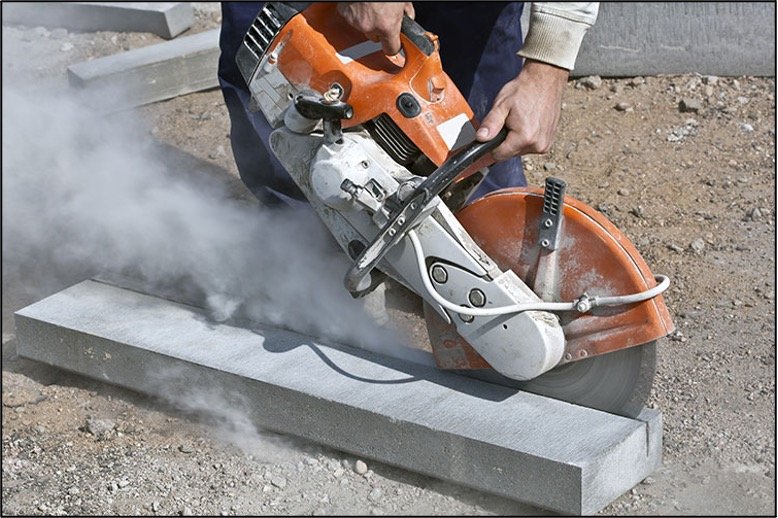Silica in construction
Date Posted: 10/28/2023
OSHA estimates that more than 840,000 workers are exposed to silica levels that exceed the new permissible exposure limit (PEL) annually. Silica is found in many materials common on construction sites, including sand, concrete, rock, mortar, stone, and brick. When workers cut, grind, abrasive blast, jackhammer, or perform other tasks that disturb these materials, dust containing crystalline silica can be released into the air. Workers who inhale this dust are at risk. Silica can cause serious, sometimes fatal illnesses, including a lung disease called silicosis, lung cancer, and chronic obstructive pulmonary disease (COPD). It has also been linked to other conditions, such as kidney disease.
Effects of Silica
Overexposure to respirable silica dust can cause many health hazards. When the small particles are inhaled, they can penetrate deep into the lungs causing dangerous and sometimes fatal lung diseases.
Overexposure to respirable silica dust can cause many health hazards. When the small particles are inhaled, they can penetrate deep into the lungs causing dangerous and sometimes fatal lung diseases.
Silicosis
According to the Centers for Disease Control and Prevention (CDC), breathing dust from silica-containing materials can lead to silicosis. Silica dust particles become trapped in lung tissue, causing inflammation and scarring. The particles also reduce the lungs’ ability to take in oxygen. This condition is called silicosis. Silicosis results in permanent lung damage and is a progressive, debilitating, and sometimes fatal disease.
Lung Cancer
Many studies have shown a relationship between silica dust and the risk of lung cancer. This is because the dust causes the lungs to scar, and this scarring can lead to lung cancer.
Chronic Obstructive Pulmonary Disease (COPD)
Silica and other dust also cause COPD. COPD includes chronic bronchitis, emphysema, bronchiectasis, and chronic airway obstruction. According to the Bureau of Labor Statistics (BLS), in 2014, COPD ranked as the third leading cause of death in the U.S., with over 147,000 deaths. In addition, COPD was projected to become the third most common cause of death worldwide by 2020.
Kidney Disease
Studies of workers have shown that increasing levels of silica exposure are associated with increased risks for chronic kidney disease.
Autoimmune Disease
Studies of workers have shown that silica exposure is associated with an increased risk for various autoimmune diseases. These diseases include rheumatoid arthritis, systemic lupus erythematosus, and systemic sclerosis (scleroderma).
How Can You Get Exposed to Silica in the Workplace?
When you cut, grind, drill, or polish certain materials like granite, engineered stone, and other stone products, very small particles of crystalline silica dust get in the air. Typical construction processes that release silica dust into the air include:
Sandblasting, abrasive blasting, and tunneling operations
Using masonry saws, grinders drills, or jackhammers
Operating vehicle-mounted drilling rigs
Sawing into brick or concrete
Using handheld powered chipping tools
Milling and operating crushing machines
Drilling into concrete walls
Grinding mortar
Using heavy equipment for demolition
Cutting or crushing stone
How Can You Protect Yourself from Silica Exposure in the Workplace?
Employers are required to evaluate procedures to identify if they create silica dust and might overexpose you and conduct a silica exposure assessment to determine if respirable silica is present at or above the action level (25 μg/m3) and in what quantities in accordance with WAC 296-840-105.
Use local exhaust or ventilation systems that capture the dust at the source and collect it in a system with HEPA filtration or water to reduce or eliminate the dust at the source before it becomes airborne. When these controls are not enough, use respiratory protection. Routinely maintain dust control systems to keep them in good working order.
Use wet methods when cutting, grinding, or breaking concrete, brick, mortar, block, or similar materials.
Do not use sand or other substances containing more than 1% crystalline silica as abrasive blasting materials. Substitute less hazardous materials.
Use NIOSH-approved respirators when exposure cannot be maintained below the permissible exposure level (PEL) (50 μg/m3) in accordance with WAC 296-842 for Respirators and WAC 296-840-125.
Wear disposable or washable work clothes and shower if facilities are available. Vacuum (equipped with HEPA filtration) the dust from your clothes and change them into clean clothing before leaving the work site. Do not brush or blow the dust off! Do not bring dust home!
Restrict access to areas on the site where silica dust is being generated.
Avoid eating, drinking, and smoking in areas where silica dust is present. Wash your hands and face outside dusty areas before performing any of these activities.
Restrict housekeeping practices, such as sweeping, blowing, or disturbing dust that may expose workers to silica where feasible alternatives are available.
Wet dust before sweeping or vacuum dust (with a dust collection system equipped with HEPA filtration) instead of sweeping it.
Shower (if possible) and change into clean clothes before leaving the worksite to prevent carrying silica dust away from the work site.
Resources
Chapter 296-840 WAC - Respirable Crystalline Silica


